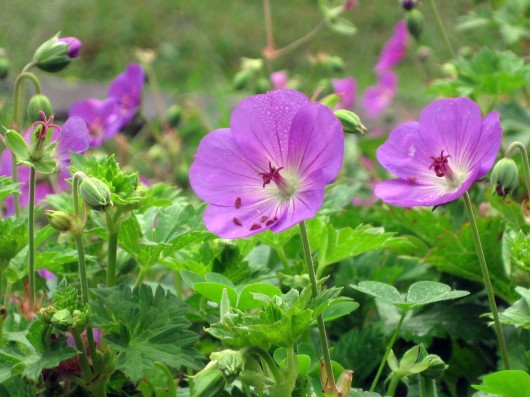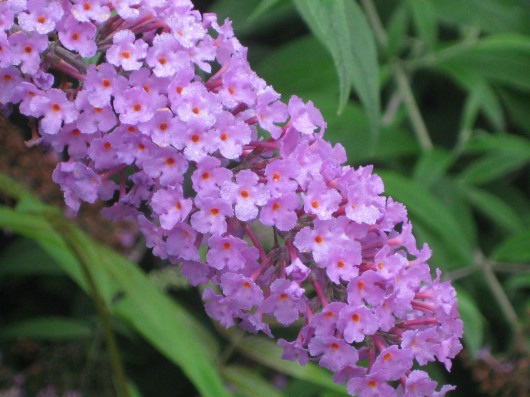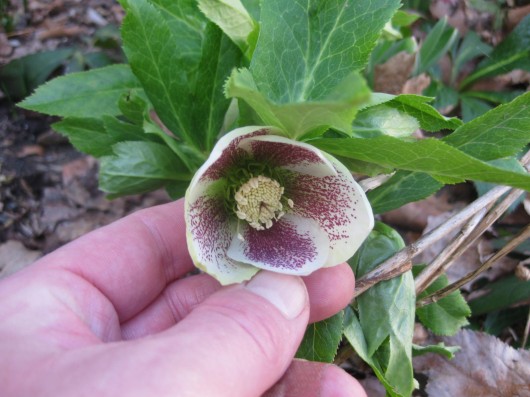 SPRING IS COMING, FOLKS! Consequently, if you haven’t winter-sown your flowering perennials yet, you really need to get hopping. For certain seeds (like the cranesbill geranium ‘Rozanne,’ above) require alternating freezes and thaws, or “stratification” in order to germinate well. Here is a list of common perennials which need this yin and yang treatment:
SPRING IS COMING, FOLKS! Consequently, if you haven’t winter-sown your flowering perennials yet, you really need to get hopping. For certain seeds (like the cranesbill geranium ‘Rozanne,’ above) require alternating freezes and thaws, or “stratification” in order to germinate well. Here is a list of common perennials which need this yin and yang treatment:
 Aconitum (Monkshood), Alchemilla (Lady’s Mantle), Alstroemeria (Peruvian Lily), Asclepias (Milkweed), Astrantia (Masterwort), Baptisia (False Indigo), Buddlejah (Butterfly Bush, pictured above), Caltha (Marsh Marigold), Caryopteris (Bluebeard), Chelone (Turtlehead), Cimicifuga (Bugbane), Clematis, Delphinium, Dodecatheon (Shooting Star), Eremurus (Foxtail Lily), Filipendula (Meadowsweet), Fuchsia, Gentiana (Gentian), Geranium species (Cranesbill Geranium), Goniolimon (German Statice), Helianthemum (Rock Rose), Helianthus (Perennial Sunflower), Heliopsis (False Sunflower)
Aconitum (Monkshood), Alchemilla (Lady’s Mantle), Alstroemeria (Peruvian Lily), Asclepias (Milkweed), Astrantia (Masterwort), Baptisia (False Indigo), Buddlejah (Butterfly Bush, pictured above), Caltha (Marsh Marigold), Caryopteris (Bluebeard), Chelone (Turtlehead), Cimicifuga (Bugbane), Clematis, Delphinium, Dodecatheon (Shooting Star), Eremurus (Foxtail Lily), Filipendula (Meadowsweet), Fuchsia, Gentiana (Gentian), Geranium species (Cranesbill Geranium), Goniolimon (German Statice), Helianthemum (Rock Rose), Helianthus (Perennial Sunflower), Heliopsis (False Sunflower)
 Helleborus (Christmas & Lenten Rose, pictured above), Heuchera hybrids (Fancy-leaved Coral Bells), Hibiscus (Hardy Hibiscus), Hypericum (St. John’s-Wort), Iberis (Perennial Candytuft), Incarvillea (Hardy Gloxinia), Kirengeshoma (Waxbells), Knautia (Crimson Scabious), Lathyrus (Perennial Sweet Pea), Lavandula (Lavender), Leontopodium (Edelweiss), Macleaya (Plume Poppy), Mazus (Creeping Mazus), Mertensia (Virginia Bluebells), Myrrhis odorata (Sweet Cicely), Nepeta (Catmint), Oenothera (Evening Primrose), Penstemon (Beard-tongue), Persicaria (Fleeceflower), Phlox (all types), Physalis (Chinese Lantern)
Helleborus (Christmas & Lenten Rose, pictured above), Heuchera hybrids (Fancy-leaved Coral Bells), Hibiscus (Hardy Hibiscus), Hypericum (St. John’s-Wort), Iberis (Perennial Candytuft), Incarvillea (Hardy Gloxinia), Kirengeshoma (Waxbells), Knautia (Crimson Scabious), Lathyrus (Perennial Sweet Pea), Lavandula (Lavender), Leontopodium (Edelweiss), Macleaya (Plume Poppy), Mazus (Creeping Mazus), Mertensia (Virginia Bluebells), Myrrhis odorata (Sweet Cicely), Nepeta (Catmint), Oenothera (Evening Primrose), Penstemon (Beard-tongue), Persicaria (Fleeceflower), Phlox (all types), Physalis (Chinese Lantern)
 Platycodon (Balloon Flower, pictured above), Primula (Primrose, all types), Pulsatilla (Pasque-flower), Ranunculus (Buttercup), Ratibida (Prairie Coneflower), Rudbeckia (Black-eyed Susan, most types), Sanguinaria (Bloodroot), Sanguisorba (Burnet), Saponaria (Soapwort), Saxifraga (Saxifrage), Scabiosa (Pincushion Flower), Sedum (Stonecrop), Sempervivum (Hen-and-Chicks), Sidalcea (Prairie Mallow), Stokesia (Stokes’ Aster), Thalictrum (Meadow-rue), Tiarella (Foamflower), Tricyrtis (Toad-lily), Trollius (Globeflower), Vernonia (Ironweed), Veronica (Speedwell), Viola species types (Violets).
Platycodon (Balloon Flower, pictured above), Primula (Primrose, all types), Pulsatilla (Pasque-flower), Ranunculus (Buttercup), Ratibida (Prairie Coneflower), Rudbeckia (Black-eyed Susan, most types), Sanguinaria (Bloodroot), Sanguisorba (Burnet), Saponaria (Soapwort), Saxifraga (Saxifrage), Scabiosa (Pincushion Flower), Sedum (Stonecrop), Sempervivum (Hen-and-Chicks), Sidalcea (Prairie Mallow), Stokesia (Stokes’ Aster), Thalictrum (Meadow-rue), Tiarella (Foamflower), Tricyrtis (Toad-lily), Trollius (Globeflower), Vernonia (Ironweed), Veronica (Speedwell), Viola species types (Violets).
The simplest way to accomplish cold-stratification is to plant seeds in covered containers, and then set them outdoors. This easy program is outlined in my post Winter-Sowing 101. Just be sure to make your plantings sooner rather than later. Don’t wait until the nightly freeze becomes the nightly thaw!
I hope the above list is useful to you.
Don’t miss anything at A Garden for the House. Sign up for Kevin’s weekly updates.
Related Posts:
Winter-Sowing 101
What to Winter-Sow…& When
How’s Your Winter-Sowing Coming Along?
Old House Living: When the Power Goes Out
How to Clean Old Windows

James says
Kevin, GREAT to have this list. Actually, I've already wintersown my perennials, including the Platycodon mentioned above.
Samantha says
I love the geranium Roseanne! Are you wintersowing it this year?
Eric says
Very helpful. Thanks!
Adele says
Do you think these perennials, if wintersown, will bloom this summer? Or will you have to wait until next year to see the flowers?
Kevin Lee Jacobs says
Samantha – No – I already have two Rozanne’s in the Serpentine Garden. I really love them, too. They bloom and bloom here from spring through frost.
Kevin Lee Jacobs says
Adele – some will bloom this summer; Campanula, for instance. Others may bloom closer to fall, while others sown this winter won't bloom until next year. But that's OK. Gardening has taught me not to hurry.
Pippi21 says
Kevin, How do you know which seeds require DO NOT COVER, COVER LIGHTLY, NEEDS DARKNESS? By any chance do you have such a list of light requirements?
Kevin Lee Jacobs says
Welcome, Pippi21. We are talking about winter-sowing outdoors in containers,
right? My own policy with seeds is thus:
Tiny, dust-like seeds: I don’t cover them. I do, however, press them down gently to insure good contact with soil. Larger seeds: sow 1/8-inch deep, never deeper.
I hope this is helpful to you; if not, kindly let me know. Keep in mind that with winter-sowing, you can generally ignore the directions on seed packets.
Anonymous says
Your blogspot is so inspirational and so informative. Thank You for sharing all of your gardening knowledge and experience. Sure wished you were my neighbor or lived in our neighborhood!
Betty819 says
Kevin, I am in love with that purple triumph tulip called Purple flag. Do you recall where you ordered it from? It's color is so different and I love its satiny texture. Those Blue Jacket hyacinths have caught my eye too. I write the names of flowers that I love from you blogspot so I can add them to my flowerbeds in 2011/2012. When you go looking at all these bulb and seed catalogs, it is helpful to have the specific names so you don't order the wrong thing. What about the exact variety of those grape hyacinths that you have planted with the Purple Triumph “Purple flag” tulips? Do you realize how many varieties there are in catalogs of this bulb? The colors are either blue or purple and sometimes look the same. You have a good eye for color..
Kevin Lee Jacobs says
Betty – Those are the same types of muscari I force for indoor bloom. The variety name is Cote d'Azure. They are truly lovely. I'm glad you like the combo — I'm drawn to purples and blues, too!
Patti says
I am trying my hand at this winter sowing… Some success so far. Assylum, morning glory, and larkspur! Its amazing… I live in zone 6. What are your thoughts on Imperial Star Artichokes???
Kevin Lee Jacobs says
Patti – Congratulations on your winter-sowing success. I was not familiar with the Imperial Star artichoke until I looked it up just now. Thanks to you, I think I’ll add it to my wish list!
Patti says
Good luck Kevin. I am trying an experiment. I started seeds indoors (on the windowsill) and out on the patio table (winter sowing). The indoor has germinated and sprouted. The outdoor …nothing yet…UGH! I will keep you posted. Thank you for your inspiring articles! Happy seeding!
Antoniette says
I gave winter-sowing a go last winter and had 2 dozen containers out in the backyard in bins. The seeds which did the best were foxgloves and lupines, I had dozens and dozens of them! Some seeds did not germinate, and it could very well be that they were older seed since I was just experimenting. Painted daisies did fabulous as well, so I’m going to plant more seeds this winter. Great January project after the holidays are over and the gardening bug starts to hit!
Jean says
Kevin: I checked on my seeds last weekend and saw that my Bachelor Buttons have sprouted. We have had a very warm winter for our zone 6 so I guess I shouldn’t have been surprised. I never thought I would like looking out my window and seeing milk jugs in my garden, but knowing what is going on inside of them makes them quite a lovely sight!! Thank you again for the inspiring ideas!!
Pat Torgrimson says
Hi Kevin,
I have wintersown seeds and put them on my back deck. They are now completly covered in snow. Should I remove some of the snow that they do get some light?
Kevin Lee Jacobs says
Jean – Congratulations!
Pat Torgrimson – No need to worry about the snow. Mine, until recently, were buried under a pile of white stuff, too.
Tammy says
As I did my annual winter sowing I was trying to figure out which flower seeds benefitted from it and which didn’t. This list is so helpful, Kevin, thank you!
Rosemary says
Having no gas stove, I used a hot glue gun (without the gluestick of course) to make the holes in my plastic milk and water bottles for winter sewing. Worked great! My gluegun is the type for hot temp. gluesticks not cold temp glue gun.
Kevin Lee Jacobs says
Tammy – Nice to hear from you. So glad you found the list helpful.
Rosemary – Hot glue gun – great idea!
trillium says
I’ve been following the directions on the seed packets, planting them however deep they were instructed to be. Will let you know if they successfully grew or not. Great, inexpensive project. I have planted about 75 containers this winter, knowing that if successful, I’ll share some of the plants.
Sandy H says
I’ve successfully started some of those, such as lavender and helianthus and rudbeckia, without stratification, so I’d check your seed pack to see if it’s absolutely required if for any reason you’re not thrilled by the idea of winter sowing. The nice thing about almost all those seeds that require it is that they are also busy self-sowers — at this point I mostly just transplant the babies. Sometimes I just throw those seeds where I want them in the garden as soon as there’s bare soil available (larkspur and alyssum work well that way).
I use winter sowing as insurance. For instance, half my onions get winter sown and half get started in the house. (Usually the winter sowing in the actual garden under the cold frame wins when it comes to size at transplant time, probably because it is less stressed by container crowding if I procrastinate planting. Sometimes it’s also the only part of the crop to avoid damping off, though now that I’ve learned about chamomile tea as a solution for that I tend not to lose much indoors to that either). The only problem this year is that my cold frame is already fully populated by spinach I sowed in December and other greens that have self-sown, so I’m going to have to make room.
Martha says
Hey Kevin–you mention perennial asclepias–how about the annual varieties? There are some wonderful ones available now. I grew some last year and saved seeds.
(These are also great for attracting monarch butterflies and finding the caterpillars.)
debra kohl says
do I need to wintersow columbine? thanks.
Kevin Lee Jacobs says
debra kohl – You don’t have to winter-sow columbine (Aquilegia). But you certain can. I winter-sowed dozens of columbine seeds back in 2010, and to my horror, every seed germinated when spring arrived!
Arianna says
Kevin, I’ve been doing “winter stratification” without knowing it by leaving my old seed packets in an unheated garage! This year, in our community garden, at the questions of the children in the area, we are trying this method, with a few differences on pecans! All of the articles promised saplings if done properly. Who knew you could get trees from your nut bowl?
Ivy says
Kevin,
I planted some turnips and mustard seeds in late October or early November and they are looking great! Ilive in the Atlanta,Ga. area I’am thinking that in terms of growing season I
am a little off is that correct?
Sandra says
Hello Kevin,
Your site is terrific! I have WS for the first time this year– and am very excited, the Malva zebrina has just sprouted. I’ve been writing the name on the outside of the milk jug — in (purple!) nail polish… shows up well, and then I keep a log of when planted, & add the date in permanent marker. It’s been so wet, the perm. marker on my earlier plantings was fading fast.
Cheers,
Sandra
Dolores Clifton says
Wow, Kevin, stumbling upon your blog a few months ago has been a godsend for me. The valuable info you share has changed my perspective on gardening, even in my high desert area. We range from 7a-5b in this capital of NV… Our state only receives 7.5″ of annual rain. Most all of our water comes from the snow pack in the Sierra’s. Through trial and error, I’ve found many successes, but I’m quite anxious to try your jug method of starting the seeds! It seems I’m usually late for starting them, then planting, whilst waiting for the last frost – we’ll get ours mid-June to July1! I can appreciate how your method really starts hardy, happy, seeds. Oh, I look forward to your weekly wisdom. 🙂
Kent says
I thought ‘Rozanne’ was sterile? You can’t get seeds for it that I know of. Plus, ‘Rozanne’ isn’t pink, as in the pic.
Shelly says
Hi
Thanks for the great site. I’m going to give this a try. My pop bottles are ready to fill and seeds are waiting to be planted. Can I use Shultz potting soil plus for my bottles? It has sphagnum peat moss composted forest products perlite lime and time released fertilizer.
Thanks. ..wish me luck !
tami says
So since I am in such a mild climate and didn’t plant my milk jugs in november we have been in the 40s since i planted them. I do have brown eyed susan, delphiniums, holly hocks and a some others that may need to freeze. Can I pop them in the freezer for a night or a few hours to pretend? also some of them are growing a little bit of mold in there is that ok? thanks kevin
Puja says
Does magnolia seed need winter stratification.. I live in India and now a days weather here is moderate.. Summer arriving. Can I saw the seeds directly in pot or need to stratified them?
Alice Marty says
What a great list of seeds that need stratifying. May I ask where you got the information? I want to copy and share with our Master Gardener group, but we must always fact check. I have been winter sowing for several years, originally inspired by Trudi Davidoff’s winter sowing site. Your blog is the absolute best for defining Winter Sowing in words and pictures, and your recipes and kitchen tips are first rate too. Simply said, “I’m a fan!”
Lori says
I was surprised that lupine weren’t on the list. I’m going to give this a whirl even tho I just read your article (I’ve been saving your articles for my “unworkable days”.). I live in northern MN so I’m probably a tad bit late as our thawing nights don’t start until April/May.
Emma Craib says
Thank you for compiling and sharing this list! The list made sorting my saved seed packets much easier 🙂
Ta Pemgrove says
I know this is an older post but it added a lot of value to my seed planning this year. Thanks for such a great reference. I got some Kiss Me Over The Garden Gate (Polygonum orientale) and have read that they need to be started cold. Do you agree? Asking since it’s not listed here and I’m a newbie at this.
Rhona says
Is it possible to spread seeds outside now for stratification? I have a wild flower area and lots of seeds I’ve collected.
dave norris says
hi – in your experience could you tell me which of the following ACTUALLY need cold-stratification and which do not? thanks!
dave norris, biologist
plymouth gentian sabatia kennedyana
rose coreopsis coreopsis rosea
new england boneset eupatorium novae-angliae
new england blazing-star liatris novae-angliae
sickle-leaved golden-aster chrysopsis falcata
groundsel-tree baccharis halimifolia
beach plum prunus maritima
northern bayberry myrica pensylvanica